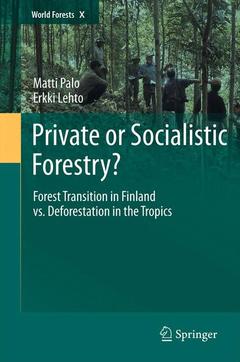Description
Private or Socialistic Forestry?, 2012
Forest Transition in Finland vs. Deforestation in the Tropics
World Forests Series, Vol. 10
Authors: Palo Matti, Lehto Erkki
Language: English
Subjects for Private or Socialistic Forestry?:
Publication date: 04-2014
464 p. · 15.5x23.5 cm · Paperback
Approximative price 210.99 €
In Print (Delivery period: 15 days).
Add to cartPublication date: 02-2012
464 p. · 15.5x23.5 cm · Hardback
Description
/li>Contents
/li>Comment
/li>
While deforestation continues at an alarming rate around the world, discussions on the range of underlying causes continue. The premise is that studying successful transitions from deforestation to sustainable forestry ex post in Finland can provide novel insights into how deforestation in the tropics might be reduced in the future. Our fundamental question here is why Finland succeeded to stop deforestation for a century ago and why not the same is feasible in the contemporary tropical countries?
This book presents a novel integrated theory within which this case study on Finland and contemporary modeling of underlying causes of tropical deforestation are developed. Finland remains the world?s second largest net exporter of forest products, while maintaining the highest forest cover in Europe. A transition from deforestation to sustainable industrial forestry took place in Finland during the first part of the 20th century. The underlying causes of this transition are compared via our theory with deforestation in 74 contemporary tropical countries. Both appear similar and support our theory.
The interaction of public policies and market institutions has appeared to be critical during this transition. The study?s findings suggest that private forest ownership with a continuous increase in the real value of forests and alleviation of poverty under non-corruptive conditions has been a necessary, but not a sufficient, condition for this transition. In a parallel way public policies have also proved to be a necessary, but not sufficient, condition in this transition.
The conclusion is that socialistic forestry along with corruption is artificially maintaining too low values in the tropical forests. The opportunity cost of sustainable forestry remains too high and deforestation by extensification of agriculture therefore continues. The prevailing socialistic forestry with dominating public forest ownership is by purpose maintaining administratively set low stumpage prices leading to low value of forests, wide corruption and continuous forest degradation and deforestation. An effective remedy ? to raise the value of forests - is found to be within forestry.
1. Rationale of the Book. 1.1 Problem of Continuous Tropical Deforestation. 1.2 Research on Causes of Tropical Deforestation. 1.3 Forest Transitions in Finland. 1.4 Role of Theories and Purpose of the Book. 1.5 Structure of the Book. References.- 2. Theory, Method and Data. 2.1 Sustained Yield Industrial Forestry. 2.2 Existing Theories of Forest Transition. 2.3 Theory of Ecological Economics. 2.4 Theory of Institutional Economics. 2.5 Theories of Property Rights and Public Goods. 2.6 Forest-based Development Theory. 2.7 Universal System Causality Model of Forest Transition. 2.8 Methods and Data. 2.9 Discussion. References.- 3. Evolution of Preindustrial Forestry in Finland. 3.1 Hunting and Gathering Economy. 3.2 Shifting Cultivation. 3.3 Conversion of Forests for Agriculture. 3.4 Industrial Exploitation of Forests. 3.5 Great Land Reform. 3.6 State Regulatory Institutions. 3.7 Informal Institutions. 3.8 International Impacts. 3.9 Discussion. References.- 4. Transition to Industrial Forestry in Finland. 4.1 De Facto Transition 1900–1960. 4.2 Ecological Conditions. 4.3 Informal Institutions. 4.4 Formal Institutions. 4.5 Enforcement of Institutions. 4.6 Forest-based Development. 4.7 Coevolution of Forestry and Society. 4.8 Inter-Sector Factors. 4.9 International Factors. 4.10 Transition to Postindustrial Forestry after 1960. 4.11 Discussion and Conclusions. References.- 5. Deforestation in the Tropics. 5.1 Deforestation Tragedy of Socialistic Forestry. 5.2 Causes of deforestation in poor and less poor tropical countries. 5.3 Underlying causes of expansion of plantations forests among tropical countries. 5.4 Causes and scenarios of deforestation in Mexico. 5.5 Role of tropical forests in alleviation of poverty. 5.6 Wild West in Uses of Forest Data in Deforestation Studies. 5.7 Failures in Global Forest Politics. 5.8 Discussion and Conclusions.- 6. Private Forestry, Community Forestry or Socialistic-Forestry for Forest Transition? 6.1 Comparison of Findingsfrom the Tropical Countries, Mexico and Finland. 6.2 Policy Implications. References.- 7. Summary of the Book. 7.1 Summary of the Rationale of the Book (Chapter 1). 7.2 Summary of the Theory of Deforestation and Forest Transition (Chapter 2). 7.3 Summary of Preindustrial Forestry in Finland (Chapter 3). 7.4 Summary: the Historical Transition to Sustainable Industrial Forestry in Finland (Chapter 4). 7.5 Summary of the Coevolution of Forestry and Society in Finland (Section 4. 7). 7.6 Summary of the Underlying Causes Terminating Deforestation and Facilitating Forest Transition in Finland 1870–1920 (Section 4.11). 7.7 Summary of the Deforestation Tragedy of socialistic-Forestry (Section 5.1). 7.8 Summary of Deforestation in Poor and Less Poor Tropical Countries (Section 5.2). 7.9 Summary: Underlying Causes of Expansion of Plantations Forests in Tropical Countries (Section 5.3). 7.10 Summary: Causes and Scenarios of Deforestation in Mexico (Section 5.4). 7.11 Summary: Role of Tropical Forests in Alleviating Poverty (Section 5.5). 7.12 Summary: ‘Wild West’ in Uses of Forest Area Data in Deforestation Studies (Section 5.6). 7.13 Summary: Failures of Global Forest Politics in Response to Tropical Deforestation (Section 5.7). 7.14 Summary: Deforestation and Reforestation Substudies Interaction (Section 5.8). 7.15 Summary: Private, Community or Socialistic Forestry for Forest Transition? (Chapter 6).




